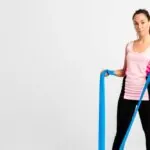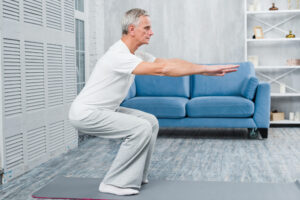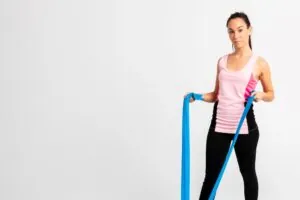Calisthenics, a form of exercise consisting of a variety of movements that use the weight of one’s own body to build strength, increase flexibility, and improve overall fitness, has surged in popularity. But beyond its convenience and simplicity, can calisthenics be an effective way to build muscle? This article dives deep into the potential of calisthenics for muscle building, examining how these exercises stack up against traditional weight training and what makes them a valuable addition to your fitness regime.
What is the process of muscle growth?
Muscle growth, or hypertrophy, occurs when muscle fibers undergo damage through physical stress, like exercise, and repair themselves to become thicker and stronger. The process involves two key mechanisms: mechanical tension and metabolic stress.
Mechanical tension is generated through exercises that stretch and contract the muscle, while metabolic stress is caused by exercises that lead to the accumulation of metabolites like lactate.
For muscle growth, a consistent application of these stresses in progressively challenging manners is essential, which can be effectively achieved through both weightlifting and calisthenics.
The potential of calisthenics for muscle building
Many skeptics question whether calisthenics can match the muscle-building potential of traditional weight lifting. While it’s true that weightlifting allows for precise load adjustments, calisthenics offers unique advantages.
The ability to manipulate body angles and leverage can create a comparable mechanical tension necessary for muscle growth. Moreover, the integration of compound movements in calisthenics not only enhances muscle synthesis but also promotes the functional strength of multiple muscle groups simultaneously.
Thus, with the right approach, calisthenics is not just a viable alternative but also a potent muscle-building strategy.
Benefits of calisthenics
One of the most significant benefits of calisthenics is its accessibility. You can perform calisthenics anywhere, without needing a gym membership or expensive equipment. This simplicity makes it an appealing option for many fitness enthusiasts.
Additionally, calisthenics exercises often involve large movements that improve joint mobility and body coordination. These exercises enhance body awareness and control, contributing to better posture and reduced risk of injuries in everyday activities.
Key calisthenics exercises for muscle gain
To maximize muscle gain through calisthenics, incorporating key exercises that target major muscle groups is essential:
- Push-ups and variations: Standard push-ups work the chest, shoulders, and triceps. Variations like archer push-ups, diamond push-ups, and decline push-ups can increase the difficulty and target different muscle fibers.
- Pull-ups and chin-ups: These are crucial for developing the back and biceps. Varying the grip (wide, narrow, reverse) can help in targeting the muscles from different angles.
- Squats and leg raises: Squats target the lower body, including the quadriceps, hamstrings, and glutes. Leg raises, performed hanging or lying down, are excellent for the core and lower abs.
Progressive overload in calisthenics
Progressive overload, a critical principle for muscle growth, involves gradually increasing the intensity of your workouts to challenge your muscles continuously.
In calisthenics, this isn’t achieved by adding more weight, as in traditional weightlifting, but rather by modifying exercise variations, increasing reps, enhancing form, or decreasing rest times.
For example, once standard push-ups become comfortable, one might progress to archer push-ups or even one-arm push-ups. This progressive increase not only stimulates muscle hypertrophy but also continuously challenges your strength, endurance, and muscle coordination, leading to comprehensive physical development.
Incorporating equipment in calisthenics
While calisthenics is predominantly bodyweight training, incorporating equipment can significantly enhance its muscle-building potential.
Tools such as pull-up bars, resistance bands, weight vests, and parallettes can introduce new challenges and variations to the workouts. Resistance bands, for example, can be used to add resistance to push-ups and squats or assist in pull-ups, making them more accessible and progressively challenging.
Similarly, weight vests increase the intensity of exercises like dips and pull-ups by adding extra weight, pushing the muscles to work harder and grow.
Common challenges in calisthenics
As with any fitness regimen, calisthenics comes with its set of challenges. Plateaus, where progress seems to halt, are common as the body adapts to the routines. Overcoming these requires altering the exercise routine, increasing the intensity, or incorporating new exercises.
Injury risk is another concern, especially when progressing to more complex movements without proper form or preparation. Ensuring adequate warm-up, maintaining proper form, and listening to your body’s signals are crucial for avoiding injuries.
Lastly, motivation can wane when progress is slow or not visibly apparent, highlighting the importance of setting realistic goals and maintaining a supportive community or workout partner.
Luckily, all these challenges you can overcome with the guidance from a personal trainer. If you are looking for a personal trainer in Americus, then visit HiTone Fitness.
Final thoughts
Calisthenics offers a unique, versatile, and effective way to build muscle and enhance overall physical fitness. It stands out due to its accessibility, adaptability, and the holistic benefits it provides. By understanding the principles of progressive overload, incorporating appropriate equipment, and focusing on nutrition, you can maximize your muscle growth potential through calisthenics.







